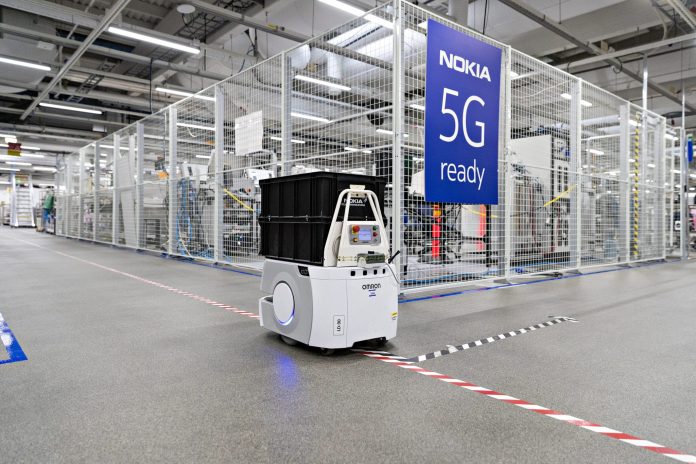Nokia has integrated key industrial IoT capabilities into its as-a-service edge networking solution for on-premise private LTE and 5G. These include high-end machine learning analytics and high-precision BLE-based positioning, plus simpler integration with Microsoft Azure IoT cloud modules and pre-engineered compatibility with core industrial connectivity protocols.
Besides, the company has said it has passed 180 private cellular deployments with new deals with the UK Home Office, in conjunction with operator EE, as well as the European Water Association (EWA) and Nippon Steel. This trio of new private LTE and 5G deployments go with a new deal with Toyota, signed in June and covered here, among its headline private networking wins during the last quarter.
The Finnish firm’s Netflix-style Digital Automation Cloud (DAC) solution, a cut-down out-of-the-box private LTE solution for easy local deployments, has until now required separate configuration of core industrial IoT applications, including the company’s own High Accuracy Indoor Positioning (HAIP) and SpaceTime scene analytics tools. It has also required separate engineering of industrial connectors to integrate IP-based cellular with prevalent machine protocols like PROFINET, EtherCAT and Modbus.
The reworked DAC integrates these functions, as standard, for both new and existing customers; separate edge hardware is no longer required to launch streaming analytics and asset tracking in local-area networks, or to integrate legacy machinery for more advanced automation and control. Nokia has also launched new voice-over-IP (VoIP) and ‘team comms’ as part of the DAC campus offer for one-to-one and one-to-many voice and video.
The point about PROFINET et al is important for future Industry 4.0 processes; the integration of industrial connectors into the DAC ‘black-box’ server will simplify the process to animate and control industrial machinery. As it stands, most digitisation efforts in the industrial space, sparked often by the kinds of private cellular initiatives Nokia is cheer-leading, have focused on attaching IP-based sensors to assets, including workers, to gather data for positioning, tracking, and monitoring.
The task to bring remote control and intelligence to operations requires getting into the bones of the machinery, in order to connect the core mechanics of the plant. Industrial machinery is critical to production, and expensive to swap-out with IP-connected upgrades; it will take a generation to overhaul and, yet, the tech industry is selling digital change now, which makes interplay with these legacy protocols a crucial function of the Industry 4.0 movement.
Meanwhile, the Azure IoT plug-in in the DAC catalogue builds on a deal with Microsoft, signed late last year, to bundle Nokia’s private cellular with Microsoft’s cloud and analytics in a joint package for operators and enterprises. UK-based BT is reselling the package as a managed service. The new integration enables deployment of Azure edge modules, the smallest unit of edge compute offered by Microsoft, geared to run both Azure services and third-party code.
Stephan Litjens, general manager of Nokia’s DAC business, said: “With its combination of high-performance wireless networking, cloud and edge computing, Nokia DAC is the ideal platform for organizations eyeing use cases such as IoT, analytics, automation and remote operations. With the new functionality and added value features introduced today, we further ease and accelerate customers’ transformation path towards Industry 4.0.”
Tuuli Ahava, head of DAC applications at Nokia, commented: “These new features address the questions facing organisations as they begin to implement Industry 4.0 use cases. Data security, backward and forward compatibility, legacy system integration, ecosystem access, and ease-of-use are just some of the concerns that the DAC platform resolves in one optimized solution.”
Nokia’s DAC offer sits alongside a full-fat private LTE and 5G solution, which goes under the Modular Private Wireless (MPW) moniker, and comes out of its original Micro-Core Network solution, and subsequent 5G-ready Compact Mobility Unit (CMU) product. The DAC solution is geared towards quick-fire local-area deployments; the MPW solution is for larger-scale campus-wide private cellular.
Nokia announced the commercial availability of an industrial-grade standalone 5G (5G SA) solution for private enterprise networks in July, alongside a new contract with the mining division of Swedish tool manufacturer Sandvik for deployment of a 5G SA network at its test mine in Tampere, in Finland.
The new 5G SA offering provides an entry point for the high-spec Industry 4.0 movement, for demanding industrial and manufacturing applications, it said. The Finnish outfit is claiming the “most comprehensive” portfolio of private LTE and 5G networking solutions in the market, with new enhancements for its high-end LTE-based enterprise proposition as well, including launch of the first Band 87 (410MHz) radio for private wireless in the public safety, transport, and utilities sectors.
Nokia claims more than 180 private wireless enterprise customers worldwide; 30-odd engagements are for industrial 5G networks, including recent deals with the likes of German rail firm Deutsche Bahn, German airline services provider Lufthansa Technik, and Japanese car maker Toyota. Nokia has been running trials with customers (including mobile operator partners, it said) since the start of 2020.

